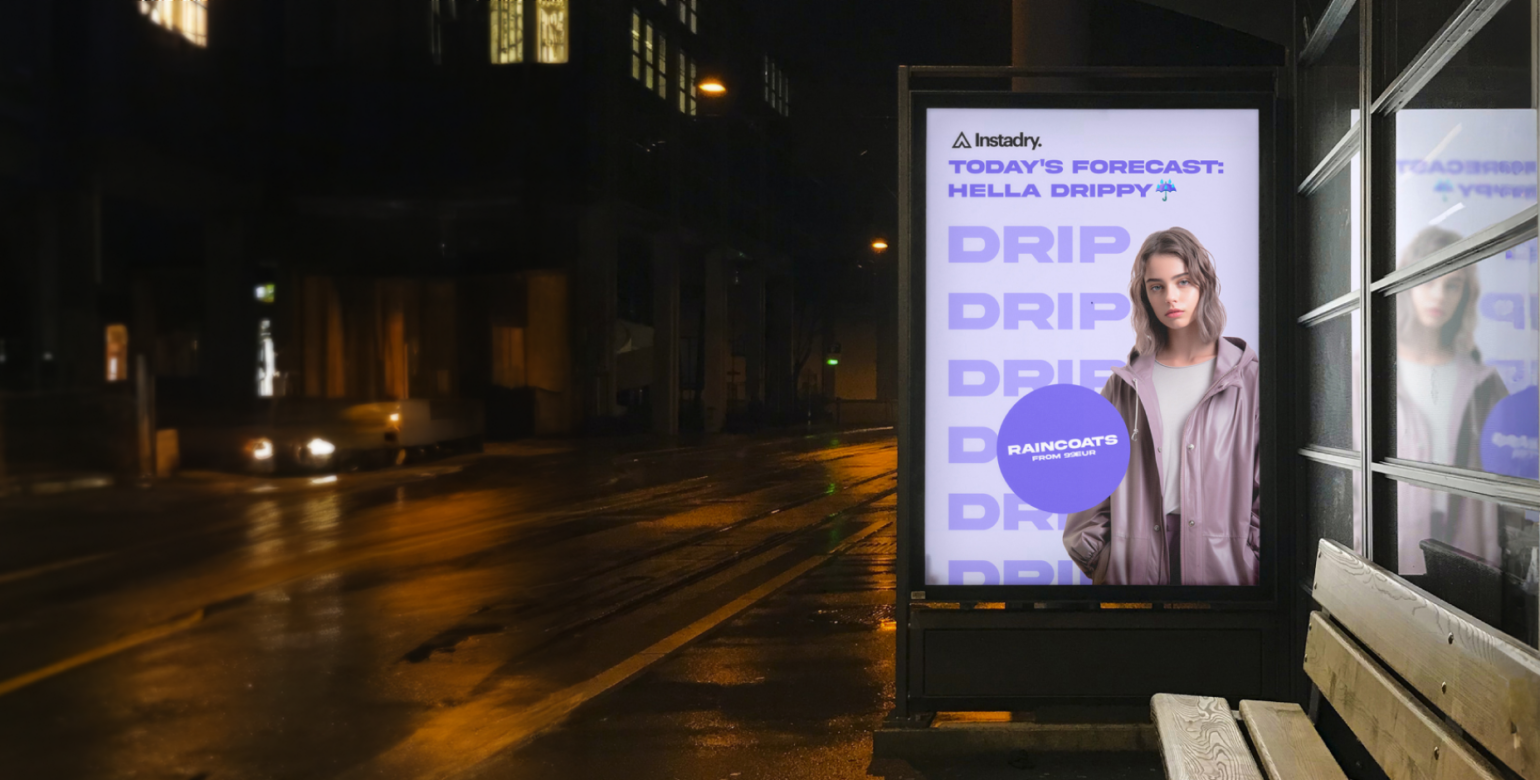What are weather ads and what can they do for your business?

Andreea-Elena Nicu
Senior Creative Solutions Engineer
Imagine waking up to the bright sun shining through your window, immediately lifting your mood. Or perhaps you start your day with rain pouring down, making you crave a cosy sweater and a hot cup of coffee. The weather isn’t just a safe small talk topic – it significantly influences our daily life, from clothing choices to shopping habits.
In this article, we discuss how using weather data in marketing through weather ads can significantly increase consumer engagement and ad effectiveness, especially in the cookieless future. We explore how tailoring advertisements to real-time, historical, and predictive weather conditions allows for more personalised and relevant campaigns.
Grab your weather-appropriate drink of choice and read along! ☕🍹
The weather’s influence on consumer trends and marketing strategies
Knowing how much the weather can impact our emotions (winter in the Nordics, anyone?), it’s fascinating to see how those same weather patterns can also significantly shape consumer trends. Noted by the British Retail Consortium, weather ranks second only to economic factors in influencing consumer behaviour. Insights from studies like the IBM Summer Behavior Survey 2022 confirm that weather conditions significantly affect consumer preferences, impacting everything from food choices to the use of delivery services. So yes, your headache and little sugar cravings can very well be related to the weather 😉
And now, this weather-and-shopping relationship has sparked a new trend in digital marketing: weather ads. These ads adjust to current, past, or forecasted weather conditions to optimise relevance. For instance, a digital billboard might display sunglasses on a sunny day and switch to gloves if a snowstorm is predicted.
By tapping into real-time, historical, and predictive weather insights, these ads enhance consumer engagement by aligning marketing messages closely with consumers’ immediate and anticipated needs. In other words, it’s all about making sure ads match up with what people need right now and what they’ll need next.
This insight into the profound impact of weather on consumer behaviour has spurred the development of weather ads in marketing and advertising Weather ads typically involve integrating with a Weather API provider. This integration enables the API to communicate with your ad-buying platform. When a request is sent to the Weather API, it assesses the configured weather triggers and delivers the advertisement that meets the set criteria.
Practical implementation and benefits
For instance, imagine a digital billboard on a bustling city street. On a sunny day, it might display an ad for sunglasses or beachwear. If the weather forecast predicts rain, the same billboard could switch to promoting umbrellas or cosy indoor activities. This flexibility allows brands to connect with consumers in a way that feels personal and intuitive.
Dynamic Creative Optimisation (DCO)
Dynamic Creative Optimisation (DCO) plays a crucial role in enhancing the effectiveness of weather ads. With DCO, marketers can automatically tailor ad content based on real-time weather conditions, ensuring that the right message reaches the right audience at the right time.
For example, a DCO-enabled campaign could seamlessly switch between promoting hot beverages on cold, rainy days and refreshing drinks during heatwaves. This level of personalisation not only boosts engagement but also maximises the impact of the advertising spend by delivering highly relevant ads.
To learn more about how DCO can transform your marketing strategy, read our detailed article on Dynamic Creative Optimisation.
What can weather ads do for you?
Integrating weather data into your marketing strategy offers several benefits:
- Increased relevance: Ads tailored to the current weather conditions are more likely to catch the viewer’s attention and resonate with their immediate needs.
- Higher engagement: When consumers see ads that align with their current situation, they’re more likely to engage, click through, and make a purchase.
- Optimised ad spend: By targeting ads based on weather conditions, you can ensure your marketing budget is spent more efficiently, reaching the right audience at the right time.
What weather data can be used?
The weather influences consumer behaviour through various “weather triggers” beyond just temperature changes. These triggers include:
- Rainfall: Promotes indoor activities, waterproof clothing, and home delivery services.
- Snow: Encourages ads for winter gear, heating products, and winter travel destinations.
- Clear skies: Ideal for promoting outdoor activities, sunglasses, and convertibles
- Cloud cover: Can drive engagement for cosy indoor products like books, movies, and home decor.
- Wind speed: Relevant for promoting windproof apparel and safety gear for outdoor workers.
- Humidity: Can influence ads for skincare products, dehumidifiers, and breathable fabrics.
- Air quality: Drives marketing for air purifiers, health supplements, and indoor exercise equipment.
- Atmospheric pressure: Useful for targeting audiences with products related to migraines or joint pain.
- UV Index: Perfect for promoting sunscreen, hats, and protective clothing.
Which client verticals should use weather ads?
Let’s switch it around and focus on business verticals vs. the weather – because yes, the weather’s influence includes almost every industry, including:
- Food and Beverage: Weather conditions affect whether people eat out or stay in, influencing food choices. For example, a rainy day might inspire ads for warm soups and delivery services, while a hot, sunny day could boost promotions for ice cream and outdoor grills.
- Electronics: Consumer decisions about indoor or outdoor activities often depend on the weather, affecting electronics usage. Rainy days might prompt ads for gaming consoles and indoor entertainment systems, while clear weather could lead to promotions for outdoor cameras and sports watches.
- Retail: Weather conditions can influence whether people prefer shopping online or visiting physical stores. On a snowy day, online shopping ads might be more effective, encouraging consumers to shop from the comfort of their homes, while a pleasant day might promote in-store shopping experiences.
- Clothing: Weather dictates our daily apparel choices, from gloves on cold days to lighter options when it’s warm. Advertisements for winter wear like coats and boots can be targeted during cold spells, whereas ads for swimsuits and shorts might be more effective in hot weather.
- Travel & Leisure: Weather can decide whether people seek a warmer holiday climate or prefer cooler retreats. During the winter months, travel ads could highlight sunny beach destinations to attract those looking to escape the cold, while cooler mountain retreats might be marketed during the summer heat.
Weather ads and data privacy
The discussion around weather ads has been evolving for many years, especially with developments like GDPR and the phasing out of third-party cookies. Now, more than ever, it’s crucial to revisit weather ads with a fresh perspective.
Weather data offers a broad, powerful signal for targeting that avoids the pitfalls of individual tracking. By focusing on general environmental conditions rather than personal user data, this approach aligns with privacy regulations and consumer expectations. It’s an effective alternative for marketers aiming to personalise their campaigns while respecting privacy boundaries.
In the future cookieless world, using weather data as a targeting mechanism will become increasingly critical. This strategy ensures that ads remain relevant and engaging without infringing on privacy, meeting both legal requirements and consumer demands for less invasive advertising. Not only does this approach comply with new privacy norms, but it also provides marketers with a way to maintain campaign effectiveness.
Conclusion
Weather data allows you to create personalised, timely ads that really connect with people. It helps you spend your ad budget more wisely, ensuring that your messages are hitting the right audience at the right time. Plus, it builds trust by respecting privacy regulations.
In the end, tapping into weather data isn’t just about keeping up; it’s about setting a new standard. It’s a win-win situation, offering better experiences for consumers and more effective results for businesses. So, why not let the weather work for you?
TL;DR
- Leveraging weather data in marketing through weather ads can significantly enhance consumer engagement and ad effectiveness.
- Tailoring advertisements to real-time, historical, and predictive weather conditions allows for more personalised and relevant campaigns.
- Weather-based targeting resonates with consumers’ immediate needs and preferences, leading to higher engagement and optimised ad spend. This approach meets the changing expectations of consumers by providing timely and contextually relevant ads.
- Weather ads align with new privacy standards, offering a compliant alternative to traditional data-heavy targeting methods.
- Using weather data for targeting is especially valuable in a future without third-party cookies, helping marketers maintain effectiveness while respecting privacy norms.
Want to know more about weather ads? Reach out to your local Creative hero ☎️


